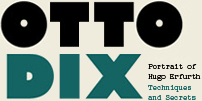
Otto Dix
Hugo Erfurth with Dog, 1926
Tempera and oil on panel. 80 x 100 cm.
Museo Thyssen-Bornemisza, Madrid
Hugo Erfurth with Dog, 1926
Tempera and oil on panel. 80 x 100 cm.
Museo Thyssen-Bornemisza, Madrid

Lucas Cranach, the Younger
Portrait of a Woman, 1539
Oil on panel. 61.5 x 42.2 cm.
Museo Thyssen-Bornemisza, Madrid
Portrait of a Woman, 1539
Oil on panel. 61.5 x 42.2 cm.
Museo Thyssen-Bornemisza, Madrid

Otto Dix was still a young and unknown painter when he returned to Dresden in 1919 after three years at the Front. He enrolled at the Academy of Fine Arts where, following various experiments with Expressionism, Futurism and Dada, he finally opted for a distinctive realist idiom that allowed him to offer a critical vision of the society that surrounded him. This new style made Dix one of the leading representatives of the New Objectivity movement (Neue Sachlichkeit). In Dix’s case, his realistic style, which he used to capture the most minute details with an almost unhealthy precision, was associated with a working method that involved numerous references to the art of the great Renaissance masters.
“My ideal was to paint like the Early Renaissance masters”, Dix stated in 1961, and we undoubtedly find evidence of this passion for Renaissance art – both Italian and German – during his time as a student at the School of Arts and Crafts when Dix would spend his free time visiting Dresden’s magnificent art collections. It was, however, from the mid-1920s that his interest in learning and applying the techniques of the great Renaissance artists became a true obsession. Dix’s paintings reveal not only stylistic analogies and similar iconographic and compositional models, but also a use of the same technical procedures. His preparatory drawings and cartoons, his way of preparing the panel and the revival of the old “mixed” technique of the German masters are the elements that allowed the artist to reach the highest level of objectivity and to expose his sitters beyond mere external appearance.
By 1926, the year in which Erfurth commissioned his portrait with his dog, Dix had become a true Old Master of modern art with a perfect command of the techniques of his artistic ancestors.
“My ideal was to paint like the Early Renaissance masters”, Dix stated in 1961, and we undoubtedly find evidence of this passion for Renaissance art – both Italian and German – during his time as a student at the School of Arts and Crafts when Dix would spend his free time visiting Dresden’s magnificent art collections. It was, however, from the mid-1920s that his interest in learning and applying the techniques of the great Renaissance artists became a true obsession. Dix’s paintings reveal not only stylistic analogies and similar iconographic and compositional models, but also a use of the same technical procedures. His preparatory drawings and cartoons, his way of preparing the panel and the revival of the old “mixed” technique of the German masters are the elements that allowed the artist to reach the highest level of objectivity and to expose his sitters beyond mere external appearance.
By 1926, the year in which Erfurth commissioned his portrait with his dog, Dix had become a true Old Master of modern art with a perfect command of the techniques of his artistic ancestors.







